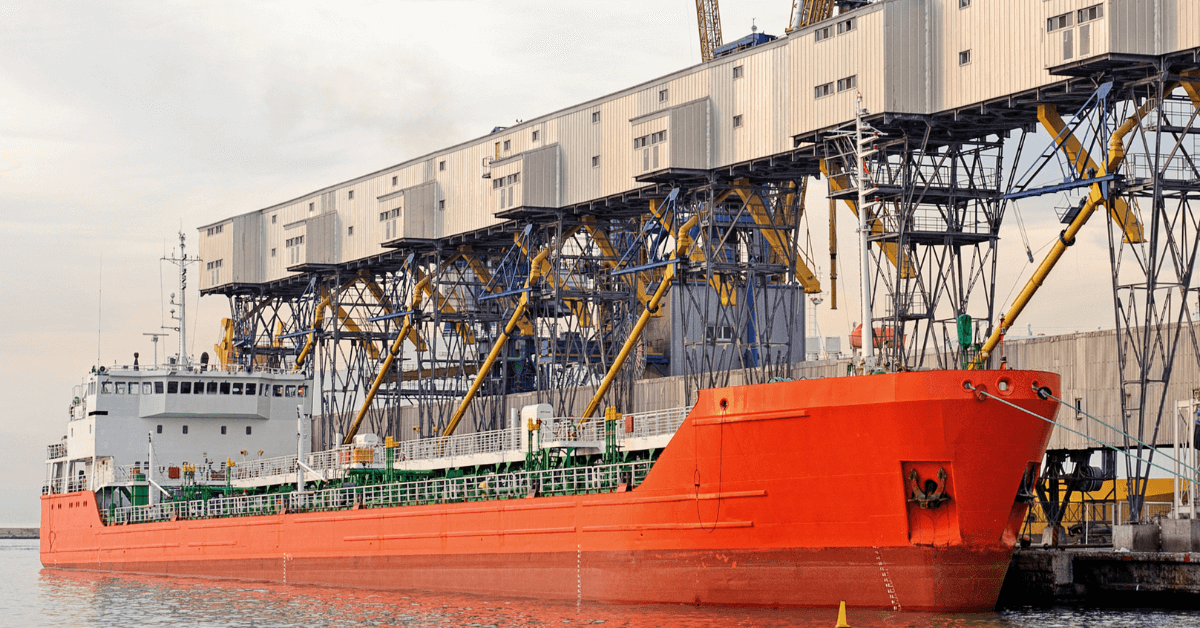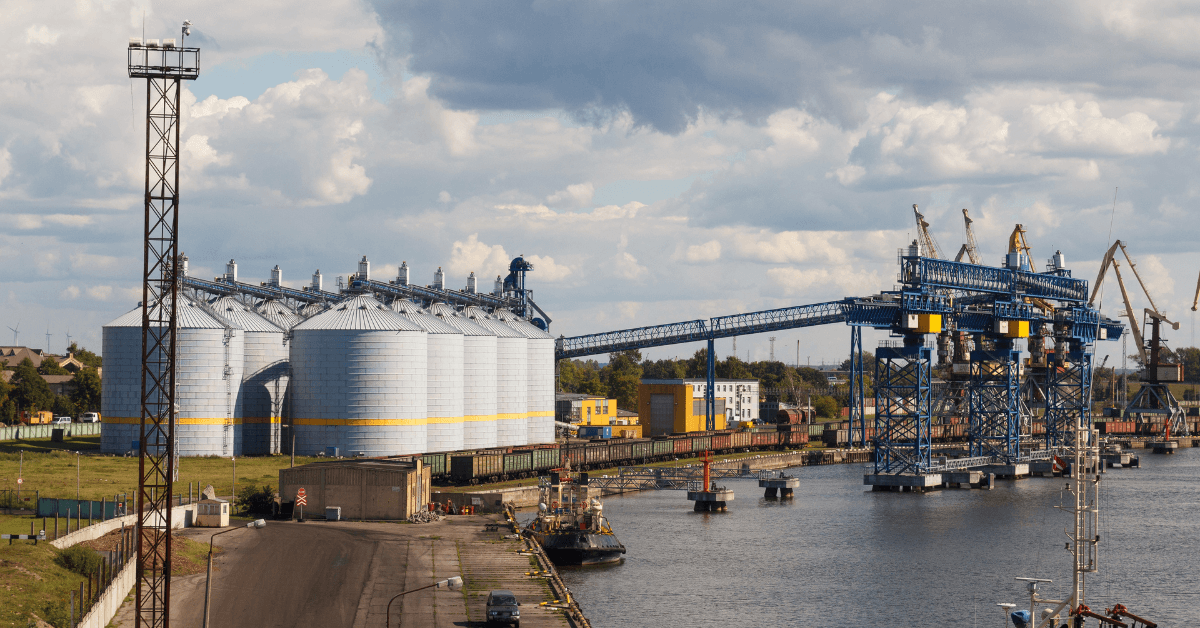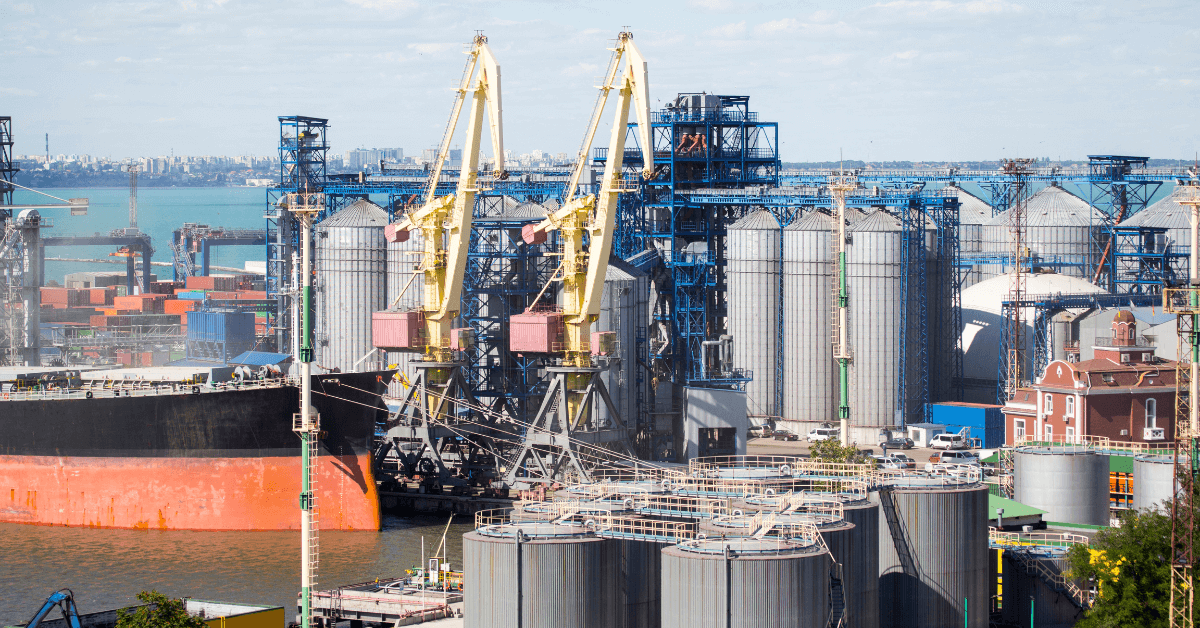What are Grain Terminals?
The world’s production of the top five food grains [corn, wheat, rice, barley, and sorghum] in 2023 is an estimated 2,738 million metric tons. It is important that excess food grains are preserved and stored under ideal conditions for use at a later time.
Following harvest, the food grains are processed, consumed, or stored for future use. Besides extending its shelf life, storage makes these staples available almost evenly and at times of necessity. It is a cost-effective solution to meet the global grain requirements over time.

In the early days, excess food grains were stored in mud pots, jars, or woven baskets. Large wooden containers or bins for holding food grains came later.
As newer and better cultivation methods came about and grain output shot up, separate shelters or storage buildings were set up to store grains. The first modern concrete grain elevator came up in the United States in 1899.
Losses Due to Improper Storage
A large percentage of food grains produced worldwide are lost due to poor storage conditions. Abiotic factors such as temperature, moisture, and humidity, as well as biotic factors like fungal, insect, and pest infestation, are to blame for this huge loss.
In India, an estimated 14 – 15 million tons of food grains are lost each year due to these reasons. Modern grain terminals help prevent such losses to a large extent.

Food grains, as they change hands from the farmer to the consumer, go through several processes, such as collection, processing, segregation, storage, weighing, and redistribution.
Grain terminals play a significant role here. Large food grain traders, grain mills, and the animal feed industries all rely on grain terminals to get their supply of food grains on time and in suitable condition.
What are Grain Terminals?
Food grain terminals are used by large farm operators and farming cooperatives to store their produce after harvest and later redistribute it. Archer Daniels Midland (ADM), Cargill, Bunge, etc., are some of the world’s leading grain companies.

Grain terminals are large food grain storage, processing, and distribution centres usually located close to major rail, road, or sea transport hubs. Such terminals consist of several large specialised silos, bins, or storage chambers, called grain elevators, to store the food grains.
A food grain terminal that handles immense volumes requires the appropriate infrastructure and specialised, efficient management to run the operations smoothly.
Grain Elevators
Grain elevators are usually made of steel, with the metal wall covering a very large, tall frame. They are also made with reinforced concrete. Their interiors are compartmentalised, and there will be mechanisms for loading and unloading the grains. Bucket elevators and pneumatic conveyor systems are used to gather and move food grains between locations within these elevators.
Operation of a Grain Terminal
The logistics involved in moving and storing very large quantities of grains can be quite challenging. Handling food grains in bulk is a major operation.

The normal steps in the operation of a grain terminal are as follows:
1. Food grains are received at the designated grain receipt areas of the grain terminal.
2. It is cleaned and weighed.
3. The grains are then shifted to a high, holding compartment called the ‘distributor’, where it gets distributed to other silos or bins (also known as grain elevators) through spouts or conveyors.
4. The grain elevators are subject to periodic disinfection, dehumidification, and other conditions required to maintain the optimum food grain storage conditions.
5. An ideal constant temperature is also maintained within the grain elevators.
6. As and when required, the grain elevators are emptied (for redistribution of food grains or cleaning of the silos or bins) using gravitational force or by conveyor mechanisms.
7. Food grains may be blended and weighed before being loaded onto transport vehicles.
This post-harvesting process is important to ensure the quality of food grains and their preservation without spoilage.
Modern Grain Terminals
Modern food grain terminals are the major storage and redistribution centres from which grains are moved to domestic or overseas markets as and when required. Most modern grain terminals are automated and can receive grains, load, unload, clean, dry, and even blend large tonnages of grains.
Precision, heavy-duty weighbridges and weighing scales help weigh and segregate the produce. Different types of grains are segregated and stored in large silos or bins. Since food grains are highly susceptible to infestation by pests and varmints, great care has to be taken to see that they are protected from such attacks. The silos have to be ventilated well, as grains get easily spoilt when they are subject to humidity, cold, or dampness.
Another hazard faced by grain elevators is grain dust explosions. Grain dust suspended in the air is highly combustible, and therefore, explosions can happen in confined spaces where there is any source of ignition, such as electrical sparks, fuel, and oxygen.
The loading and unloading bays attached to grain elevators are usually designed to receive from or load trucks, rail wagons, or barges. Most of the earlier grain elevators used to be located near railway lines. However, with the advancements in transport, they are found in places close to ports or inland transport hubs.
Modern conveyor systems help to move large quantities of food grains to the right locations within the terminal as required. Most conveyor systems, powered electrically, are horizontal or vertical conveyors. These conveyors help move grains between compartments inside a silo or bin or between silos.

Modern grain terminals are equipped with weighbridges and scales for weighing the food grains. They have temperature measurement and control devices, pest and varmint control mechanisms, dust control mechanisms, automatic ventilation of the grain elevators, etc. They are also explosion-proof as a safeguard against grain dust explosions. Various energy-saving methods are usually employed here to reduce costs and overhead expenses.
Most grain terminals are all-weather terminals that operate 24/7. They have good connectivity between production centres and transport hubs, and modern technologies optimise their processes.
The logistics of receiving and moving food grains should be seamless and efficient to the highest degree, ensuring that there are no loading bottlenecks or any other congestions during movements. All the more so because the commodity is highly perishable and one of the most basic requirements for the food security of any country.
Several companies specialise in building customised grain terminals and in customising the installation of grain elevator systems, conveyor technologies, and loading and unloading facilities.
Modern grain terminals and elevators have come a long way from their earlier counterparts. Wooden food grain elevators of the early days were susceptible to fire and other elements of nature. Frank Hutchinson Peavey of the United States is credited with building the first grain elevator from concrete in 1899.
Most of the grain elevators used in grain terminals these days are cylindrical and made of reinforced concrete. With 310 grain elevators, at 2,700 feet in length and 100 feet in width, the world’s largest food grain terminal is the DeBruce Grain Inc. in Kansas, US.
You might also like to read-
- 11 Major Container Terminal Operators In The World
- What Are Automated Container Terminals?
- How Does LNG Terminal Works?
- Marine Terminals : Providing Utility with a Difference
Disclaimer :
The information contained in this website is for general information purposes only. While we endeavour to keep the information up to date and correct, we make no representations or warranties of any kind, express or implied, about the completeness, accuracy, reliability, suitability or availability with respect to the website or the information, products, services, or related graphics contained on the website for any purpose. Any reliance you place on such information is therefore strictly at your own risk.
In no event will we be liable for any loss or damage including without limitation, indirect or consequential loss or damage, or any loss or damage whatsoever arising from loss of data or profits arising out of, or in connection with, the use of this website.
Do you have info to share with us ? Suggest a correction
Disclaimer :
The information contained in this website is for general information purposes only. While we endeavour to keep the information up to date and correct, we make no representations or warranties of any kind, express or implied, about the completeness, accuracy, reliability, suitability or availability with respect to the website or the information, products, services, or related graphics contained on the website for any purpose. Any reliance you place on such information is therefore strictly at your own risk.
In no event will we be liable for any loss or damage including without limitation, indirect or consequential loss or damage, or any loss or damage whatsoever arising from loss of data or profits arising out of, or in connection with, the use of this website.

About Author
Hari Menon is a Freelance writer with close to 20 years of professional experience in Logistics, Warehousing, Supply chain, and Contracts administration. An avid fitness freak, and bibliophile, he loves travelling too.
Daily Maritime News, Straight To Your Inbox
Sign Up To Get Daily Newsletters
Join over 60k+ people who read our daily newsletters
By subscribing, you agree to our Privacy Policy and may receive occasional deal communications; you can unsubscribe anytime.



